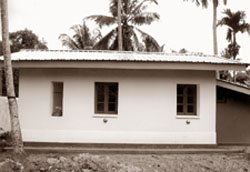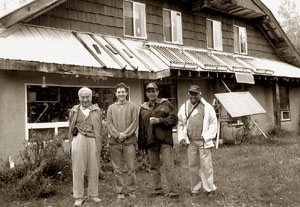|
dailynews |
|
|
|
|
|
OTHER LINKS |

|

|

|
|
World experts commend pioneering efforts of Sri Lanka: Going green in the construction industry
GREEN TECHNOLOGY: The attention of scientists and technocrats world over is increasingly focused on so called 'Green Technologies', as a solution for the anticipated energy crisis our future generations will have to face. One third of the world population living in 'Developed' countries consume over two thirds of the energy produced in the world leaving only a share of less than one third for the rest, two thirds. Owing to the heavy industrialisation that took place after the Industrial Revolution, per capita energy consumption in the world has risen exponentially, depleting the planet's limited energy sources very fast. Construction and building material production industry is responsible for a significant share of energy consumption and Carbon Dioxide emission to the atmosphere. These current trends will deprive the rights of our future generations to live comfortably unless we take corrective measures now. Nearly 200 scientists, technocrats, academics and builders from 12 countries, both from East and West, gathered recently in Camp Kawartha at Lakefield, Canada to deliberate on the above theme. More specifically, they examined the potential of straw to be used to replace high energy consuming construction materials such as cement, concrete, steel or even bricks. The event was a week long affair from September 23 to October 1, and was named 'International Straw Bale Building Conference - 2006' (ISBBC 2006). ISBBC is a by-annual event attended by the international community working on straw and similar nature friendly technologies. The conference was organised this time by the Ontario Straw Bale Building Coalition in Canada and was the fifth Straw Bale International Conference. Several eminent personalities in the field of 'Green Technology', delivered speeches. The camp Kawartha, the venue of the conference, has been thoughtfully selected to match with the theme. It was in the middle of woods to allow the participants to get a touch of nature. The Asian region was represented by China, Pakistan and Sri Lanka. The Chinese delegation made a presentation on their experience in straw construction in a project which won the UN Habitat award last year and Pakistan presented a post earthquake straw bale housing project. The presentation by Sri Lanka, on 'The First Straw Bale House in Sri Lanka' was a highlight of the seminar and was commented by many world experts for the pioneering effort of the Sri Lanka's research team. The team from Sri Lanka comprised Inagami Shozo, a Japanese researcher working for dissemination of Straw Bale Technology in Sri Lanka, his Sri Lankan co-researcher Piyal Ganepola, an Engineer in the housing sector and Mervin Perera, who was in-charge of construction of the first SB house. This research team has constructed the first SB house at Kalagedihena, Gampaha and is researching on the adaptability of the technology in Sri Lanka. Ganepola, who made the presentation on the Sri Lankan straw bale project, stated that the project aims to test the technical applicability of the SB technology to the Sri Lankan tropical atmosphere. (Straw bales are masses of straw compressed and bound into rectangular blocks). He further stated that many countries in the American and European continents and Australia has recognised SB technology within their building codes. International engineering testing authorities have tested and proved that plastered SB walls have much better fire resistant qualities and insulation qualities than many conventional building materials and that they last very long if protected from moisture. According to Ganepola, justification to use straw in construction in Sri Lanka is different from that of countries with distinct seasons; winter and summer, where thermal insulation is the main advantage. Here in Sri Lanka we utilise very little of our rice straw as fodder and fertiliser and burn the rest adding toxic gases to the environment. On the other hand we destroy our environment by building with technologies introduced to us by Westerners in the colonial period. As examples he quoted the sand extraction in river beds and destroying trees to burn bricks. Another concern is the draining of foreign exchange for importing building materials and products. Straw Bale technology offers opportunities to masses of our unskilled labour force to gainfully contribute to build houses as the technology is very simple. SB technology has a range of applications from ultra comfort tourist accommodations to affordable low cost housing which creates a good condition space for SB technology to become sustainable in Sri Lanka. Straw has unbelievably excellent qualities as a construction material which the Sri Lankan construction industry has yet to realize. Several ways of using straw to build walls of buildings too, other than straw bales, were presented in the conference. |









